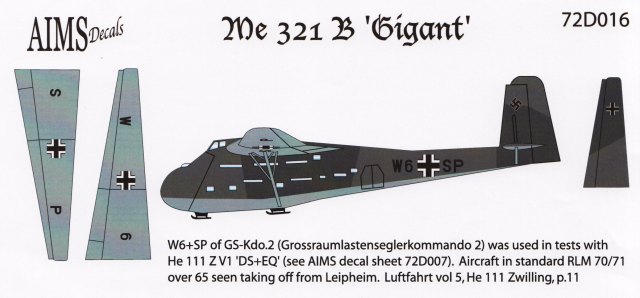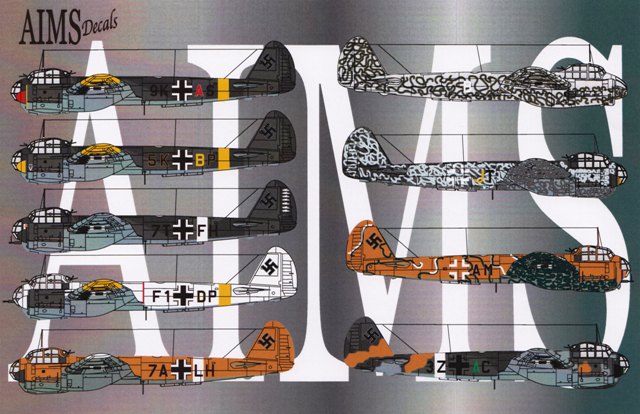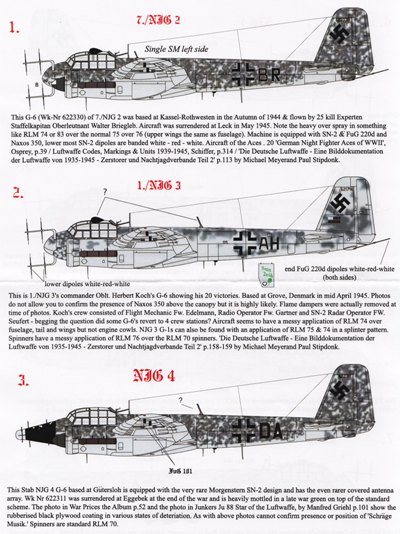Reviews for the Italeri 1/72 German Me 323 Gigant
3 Decal Sheets
Messerschmitt Me 323
Junkers Ju 88 C-six

AIMS Decals, 1/72 and 1/48 scale
| Summary | |
| Catalogue Number: | AIMS Decals |
| Scale: | 1/72 and 1/48 |
| Contents and Media: | Waterslide decals plus colour instructions |
| Cost: | Available online from AIMS' website (Paypal accustomed) |
| Review Blazon: | FirstLook |
| Advantages: | Varied and interesting subjects; Abrupt articulate press; superb colour registration; sparse carrier film. |
| Disadvantages: | |
| Conclusion: | A quality production which allows the modeller to choose a scheme other than that plant in the kit. |
Reviewed by Rob Baumgartner

HyperScale is proudly supported by Squadron.com
F i r south t L o o k
AIMS is a company that started in February 2003. Usually they concentrate their efforts on the venerable Ju 88 so it was no surprise that the following 1:48 scale offerings made their appearance last year.
Thumbnail panels:
![]()
In that location was one unexpected release however, and this came in the form of a decal sheet for the Me 321 "Gigant". It is designed for the 1:72 scale Italeri kit and covers 3 interesting and varied colour schemes.
- Me 321 B "W6+SP" of GS-Kdo.2 (Grossraumlastenseglerkommando 2)
This shipping was used in tests with He 111 ZV1 "DS+EQ" (a car that AIMS also provides decals for on sheet 72D007). Information technology was photographed taking off from Leipheim and wears the standard RLM seventy/71/65 scheme.
- Me 321 B "W6+SW" of GS-Kdo.2 (Grossraumlastenseglerkommando 2)
Seen in conjunction with He 111 Z "TM+KI" (run across AIMS sheet 72D010) this machine is finished in temporary wintertime camouflage with very footling of the underlying scheme showing through. The appointment and location are believed to be January 1942 at Kertsch in the Crimea.
- Me 321 B "W6+SK" of GS-Kdo.ii (Grossraumlastenseglerkommando 2)
The combination of the above two schemes topped off with yellowish wingtips and fuselage band brand this the well-nigh colourful aircraft of the trio. Unfortunately no other details of its service history are bachelor.
The decal canvas was printed by the Fantasy Printshop and everything was in perfect register. The carrier flick is very sparse and is kept to a minimum effectually each item.
48D002 - Ju 88 A/D/Southward
Nine aircraft can be found on this release that covers iii versions of the famous Ju 88. They are printed on a single canvass of A5 size decal paper, a feat made possible by only supplying enough national markings for a unmarried aircraft.

A fascinating diversity of colour schemes is available for the modeller to cull from. Whether it is a simple Mediterranean example or 1 with a circuitous "scribble" pattern, at that place should be something for all tastes.
- Ju 88, "9K+AS" of 8./KG 51.
Based at Nikolajew, Southern Crimea during March 1941, this Ju 88 is finished in RLM70/71/65 with xanthous fly tips and fuselage band. The spinners are in ruby.
- Ju 88 A-4, "5K+BP" of 6./KG iii.
Seen in the Ukraine during mid 1942, the aircraft wears the aforementioned scheme equally above but with the xanthous extending to the spinners equally well. The rare engine cowl marking has a slight mistake, as pointed out in the instructions, just this is pocket-size.
- Ju 88, "7T+FH" of KGr 606.
Although redesignated 1./KG 77 in Sept 1942, it still shows the old codes when flying in 1943. It's also covered in the standard decor of the day and is flattered with an impressive collection of "impale" markings on the rudder.
- Ju 88 "F1+DP" of 6./KG 76, 1943.
Thanks to its winter service on the Eastern Forepart, the shipping is seen wearing the customary temporary "whitewash". The contrasting engine covers make an interesting focal bespeak equally they still testify their original cover-up finish thank you to what must have been a late engine change.
- Ju 88 D-1, "7A+LH" of one.(F)/121.
Seen in the desert scheme of RLM78/79, this machine was constitute by Canadian forces in Libya during 1943. It features the white theatre band around the fuselage and possibly under the wing tips besides.
- Ju 88 "3Z+Ac" of Stab. Two/KG 77, 1943
The aircraft carries the usual colours of RLM 70/71/65 but with additional patches of what is believed to be RLM79 and RLM65 on the uppersurfaces. Although the profile lacks the white centres institute in the fuselage cross, the correct versions are included on the decal sheet.
- Ju 88 A-4, "B3+AM" of 4./KG 54
Photographed in Catania, Sicily during the spring of 1943, it's finished in RLM78/79 with white crested RLM80 stripes. The "scribble" on the under surfaces is also believed to be in dark green.
- Ju 88 A-17, "3Z+JT" of 9./KG 77.
This scheme will actually test the skill of the modeller. The RLM seventy/71 splinter design is well hidden under the heavy RLM 76 "scribble" which also appears in RLM 70 or RLM 80 on the undersides. Based in Southern Europe during the Spring of 1943, it was one of the aircraft that carried rocket packs for assisted takeoff.
- Ju 88 Southward-3 of 1./KG 66.
Having slid off a runway most Frankfurt in the winter of 1944, this motorcar gave the photographer a perfect opportunity to record the late war improvised "scribble". It'south in RLM 82 over the upper surfaces, which in itself is a patchwork of presumed RLM 77/76.
To help the modeller brand their ain conclusions regarding the colour schemes, AIMS thoughtfully provide the reference sources for all their profiles.
48D001 - Ju 88 G-six and Mistel S-3C Collection
Apart from the allure of nightfighter operations, the Ju 88 is also popular for the variety of cover-up and antenna arrays seen on these aircraft.

This sheet has 14 such combinations also as a couple of "Mistel" trainers to cull from.
- Ju 88 Thousand-6, Wk.Nr 622330, of 7./NJG two
In the autumn of 1944, this aircraft was based at Kassel-Rothwesten and was flown by 25 victory ace Walter Briegleb. It was given up at Leck in May 1945 and was equipped with SN-2, FuG 220d and Naxos 350.
- Ju 88 G-6, Wk.Nr 621796 of 1./NJG 3
It's the shipping of another ace, this time Oblt. Herbert Koch, who managed to amass a full of 20 victories. In April 1945 it was at Grove in Denmark and carries SN-2 and most likely Naxos 350 although the latter is not visible in photographs.
- Ju 88 K-vi, Wk.Nr 622311 of Stab NJG four
For those wanting something dissimilar, this scarce example of the Morgenstern SN-2 blueprint is just the matter. Based at Gütersloh, it also has the rarer covered antenna array and was somewhen surrendered at Eggebek in 1945.
- Ju 88 One thousand-6, Wk.Nr 622959 of NJG 4
Not many details can exist ascertained near this aircraft as the photo it comes from shows a machine in quite a country of disrepair. At that place is no FuG220d nether the rudder simply it does conduct FuG 220b on the vertical stabilizer.
- Ju 88 G-6, Wk.Nr 620643, of v./NJG 4
This is another aircraft seen at Wunstof nigh Hannover in May of 1945. The red in the aircraft fuselage code and rear part of the spinner add a flake of extra colour.
- Ju 88 Thousand-half-dozen, Wk.Nr 622811, of eight./NJG 4
Also as the involvement provided past the replacement rudder, this shipping as well features FuG 240 Berlin and FuG 217. The machine was institute at Flensburg and a further focal bespeak is the minor letter "G" on the plywood embrace.
- Ju 88 G-6, Wk.Nr 620788, of NJG five
Although flown by 64 victory ace Maj. Rudolf Schoenert, this machine is not believed to have been flown in combat. Information technology is experimentally fitted with actress FuG 220 diploes on the fuselage and carries Naxos 350 above the cabin and FuG 220b on the vertical stabiliser.
- Ju 88 Grand-6, Wk.Nr 623193, of NJG 5
This is the second aircraft featured on the sheet to bear FuG 240 and FuG 217. Twin "Schrage Musik" is located in the mid fuselage position and the mottle of multiple colours make information technology an bonny scheme to model.
- Ju 88 G-half dozen, of stab 2./NJG 5
Based on a poor quality image, this contour shows the mount of 30 victory ace Major Hans Leikhardt. Information technology was located at Magenau in late 1944 and is one time again fitted with the rare Morgenstern SN-two organisation.
- Ju 88 1000-6, Wk.Nr 623211, of 7./NJG 5
Hauptmann Hopf flew this FuG 218 Neptune equipped shipping when it arrived in Switzerland on 30 April 1945. Due to the dumbo mottle, the Swiss had to repaint the markings in white before releasing the subsequent photos to the media.
- Ju 88 One thousand-six, Wk.Nr 620751, of iv./NJG 6
Not much is known well-nigh this car other than its capture at Aschaffenburg in Germany during May 1945. The soft mottling of RLM 75 on the fuselage sides is in straight contrast to the more than spider web-like pattern on the wings.
- Ju 88 G-vi, Wk.Nr 621197, of NJG Staffel Norwegen
This interesting shipping carries the blackness underwing colouring that was used as a recognition marker for a short menstruation of time. It had previously been used to evacuate troops from the Eastern Front before beingness surrendered to the Americans.
- Ju 88 G-6, Wk.Nr 623363, of NJG Staffel Norwegen
Sweden got an unexpected visitor when Hauptmann Werner Hüschend force landed his aircraft at Bredakra later on suffering engine issues. He as well was involved in evacuating troops in the concluding stages of the war.
- Ju 88 G-vi, Wk.Nr 622891
This is one machine that manifestly didn't get to serve with a frontline unit. It was lounging around at the Bad Langensalza airfield, waiting to be delivered to its new owners.
- Mistel S3C, Wk.Nr 460066 & 16. Mistel S3C, Wk.Nr 460065
These last two shipping were found at the main examination facility for the Ju 88 program at Bernburg in Eastern Frg. The Americans occupied the place on twelfth April before handing it over to the Russians who eventually transferred the whole plant dorsum to their country.
Determination
AIMS has provided an splendid variety of shipping for the modeller to choose from, with plenty of colour schemes to cater for all levels of painting skill.
The referencing of subjects to the photographs they were based on is essential for Luftwaffe aircraft. Thankfully the manufacturers do this, as information technology allows the builder to make up their ain listen should they disagree with a conclusion.
Information technology would have been nice to have a representative topside painting guide regarding some of the profiles though. The flow images of some of these shipping evidence quite a different design to that seen illustrated on the fuselage sides.
Each sheet was printed with perfect registration and the carrier film is commendably thin.
The end result is iii more quality decal sheets from which to pick your side by side favourite Luftwaffe subject.
Thank you to AIMS for the samples
AIMS' decals, kits and accessories are available online from AIMS website
Text and Images Copyright � 2011 by Rob Baumgartner
This Folio Created on vii March, 2011
Last updated vii March, 2011
Back to HyperScale Main Page
cousinlonswellot58.blogspot.com
Source: https://www.hyperscale.com/2011/reviews/decals/aims72d016reviewrb_1.htm
Post a Comment for "Reviews for the Italeri 1/72 German Me 323 Gigant"